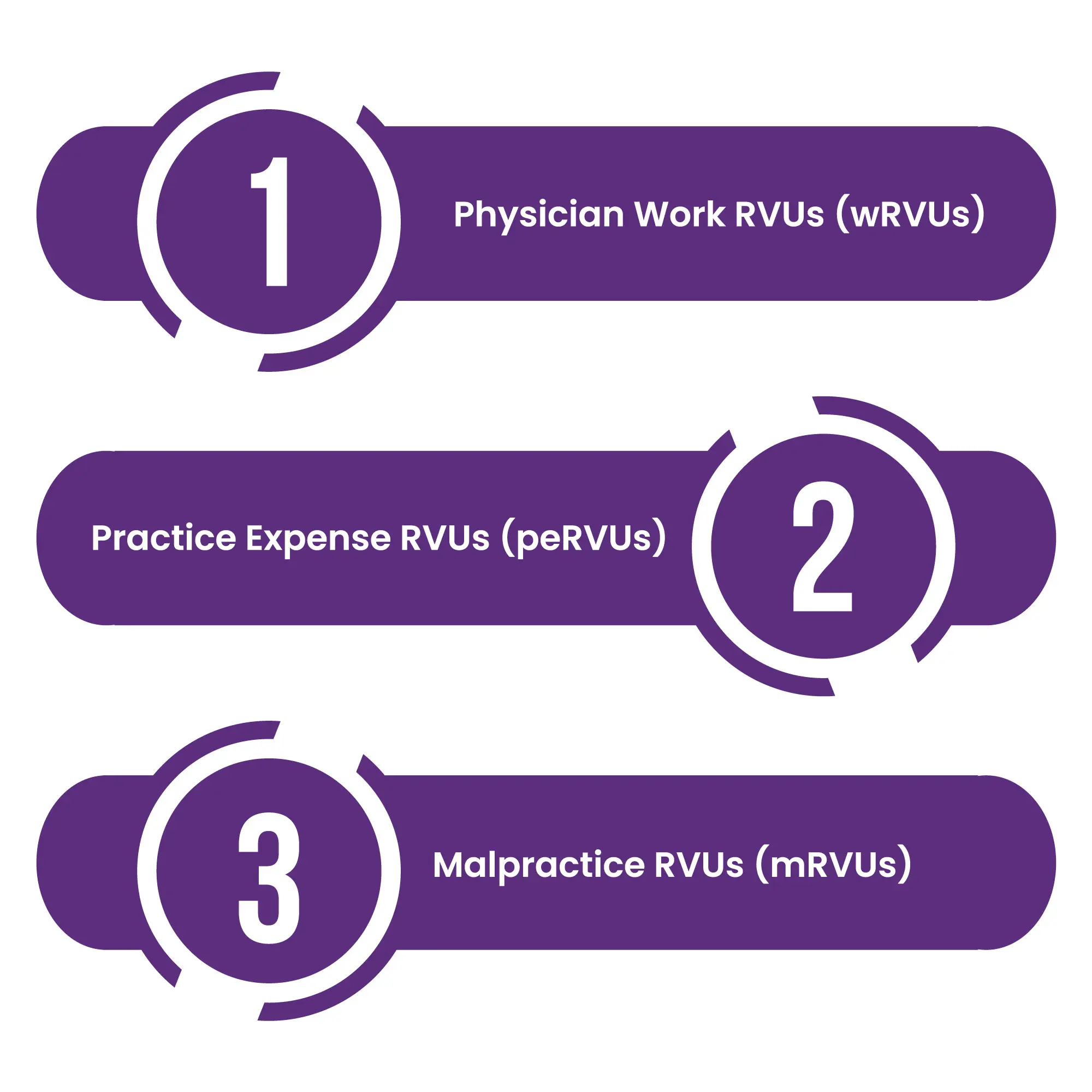Do you know healthcare providers' compensations are tied to a system of relative value units (RVUs)? If you aren't familiar with medical billing, RVUs may sound like a foreign term to you. But don't worry; we're here to explain what RVUs mean in medical billing and how it affects provider compensation.
What are RVUs?
RUV Is a medical term that is an acronym for Relative Value Units these are numerical values assigned by the Center of Medicare Medicaid Services (CMS) to medical procedures or services provided by healthcare providers. These values are part of the Medicare resource-based Relative Value System, which was authorized in 1989 and implemented in 1992 alongside the Medicare Physician Fee Schedule (MPFS). RVUs play a crucial role in determining the reimbursement rates for healthcare services, reflecting the complexity and resources required for each procedure or service.
What is the Purpose of an RVU?
Before the introduction of RVUs, there was a significant discrepancy in how medical services were valued and compensated. Providers charged based on their unique scales, leading to widespread variability and often, unfair compensation practices. This inconsistent approach made it arduous for Medicare, as a national program, to maintain fairness and transparency in provider payments.
Notably, while RVUs introduced a standardization in the billing process, they also recognize the variability in the effort and resources required by different healthcare providers. The complexity, length, risk, and required skill level of procedures can differ significantly across specialties and even among physicians within the same specialty.
For instance, a procedure that involves surgery would naturally command a higher RVU than a routine consultation, reflecting the surgical specialist's extensive training and the high degree of skill and risk involved in the operation. Similarly, experienced practitioners who perform more complex procedures or handle complicated cases might generate higher RVUs compared to their peers handling standard cases.
Furthermore, the geographic practice cost indices (GPCI) adjustments made to the RVUs account for the economic variations across different locations. These adjustments ensure that providers in areas with higher costs of living or operational expenses do not face undercompensation due to uniform RVU values.
How to Determine RUV for a Service In Medical Billing?
Understanding how Relative Value Units (RVUs) are determined for each service in medical billing requires a deep dive into its components. Each RVU encompasses three essential elements, representing different aspects of healthcare provision. Here's how each component is factored into the RVU, complete with examples for clarity.

1. Physician Work RVUs (wRVUs):
This element of the RVU accounts for the time, technical skill, mental effort, judgment, and stress related to the physician's provision of service. Essentially, it's a measure of the professional input and responsibility required in the performance of a medical service.
Example: Consider two scenarios - a routine check-up versus a complex surgical procedure. The routine check-up may require relatively less time, lower intensity of decision-making, and minimal stress, leading to a lower wRVU. In contrast, a complex surgical procedure demands extensive expertise, high mental effort, longer engagement time, and bears a higher risk. Consequently, it carries a higher wRVU, signifying the intensive nature of the physician's work involved.
Practice Expense RVUs (peRVUs):
These RVUs reflect the costs involved in maintaining a practice, including rent, non-physician staff salaries, equipment, and supplies—essentially, all the overheads that a physician incurs while providing medical services.
Example: Let's use an MRI procedure for this instance. The practice expense for conducting an MRI is considerably high, considering the cost of the MRI machine, the specialized environment needed for housing the equipment (like a shielded room), the technical staff operating the machine, and the supplies used during the procedure. All these expenses contribute to a higher peRVU for an MRI compared to, say, a standard blood pressure reading taken in a basic consultation room with minimal equipment and supplies.
3. Malpractice RVUs (mRVUs):
This component accounts for nvasive surgical procedures, meaning the physician's malpractice insurance must cover more considerable potential liabilities. Therefore, the mRVUs for open-heart surgery will be significantly higher than for a relatively straightforward, low-risk flu shot.
| RVU Component | Description | Approximate Percentage |
|---|---|---|
| Physician Work RVUs | Time, effort, skill, and stress associated with the physician’s performance of a service. | 51% |
| Practice Expense RVUs | Overhead costs of maintaining a practice, including staff, equipment, and supplies. | 45% |
| Malpractice RVUs | Cost of malpractice insurance based on the risk associated with the service provided. | 4% |
How are RVUs calculated?
Calculating Relative Value Units (RVUs) is a comprehensive process that requires understanding each component involved in determining the value of medical services provided. This system is essential for standardizing compensation for healthcare providers, especially under Medicare. Here's how RVUs are calculated, including the formulas and some context on RVUs per hour and per visit.
RVU Calculation Formula:
The total RVU for a specific service is calculated by summing the individual RVU components and adjusting for geographic cost variations. Here's the formula representing this calculation:
Total RVU = Work RVU + Practice Expense RVU + Malpractice RVU
Once the total RVU is determined, it's multiplied by a conversion factor (CF) to calculate the reimbursement rate:
Reimbursement = Total RVU x Conversion Factor (CF)
The conversion factor is a dollar amount set by the Centers for Medicare & Medicaid Services (CMS) and can change annually based on the healthcare economic landscape and legislative updates.
Geographic adjustments:
To account for the cost discrepancies in different areas, the total RVU is often adjusted using the Geographic Practice Cost Indices (GPCI). Here’s how:
Geographically Adjusted Total RVU = (Work RVU x Work GPCI) + (Practice Expense RVU x Practice Expense GPCI) + (Malpractice RVU x Malpractice GPCI)
The resulting geographically adjusted total RVU is then used in the reimbursement calculation with the conversion factor.
RVUs per Hour and per Visit:
RVUs Per Hour: This metric is crucial for understanding physician productivity, especially in scenarios where healthcare providers are compensated based on their efficiency. To calculate RVUs per hour, you divide the total RVUs a physician generates within a specific timeframe by the total hours worked during the same period.
Formula: RVUs per Hour = Total RVUs Generated / Total Hours Worked
RVUs Per Visit: Similarly, to gauge productivity per patient encounter, medical practices calculate the RVUs per visit. This involves dividing the total RVUs associated with a physician’s services by the total number of patient visits during a specific timeframe.
Formula: RVUs per Visit = Total RVUs Generated / Total Patient Visits
Final Words
Understanding RVUs is crucial for healthcare providers, medical billers, and insurance companies alike. It's the foundation of determining physician compensation under Medicare and provides a standardized way to compare the value of different medical services. By knowing how each RVU component is calculated, it becomes easier to appreciate the complexities involved in establishing reimbursement rates and how they impact physicians' work and overall practice expenses.
ABOUT AUTHOR

Joseph Shahab
As a blog writer with years of experience in the healthcare industry, I have got what it takes to write well researched content that adds value for the audience. I am a curious individual by nature, driven by passion and I translate that into my writings. I aspire to be among the leading content writers in the world.
